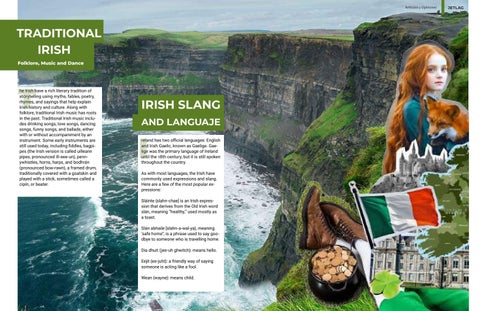Articulos y Opiniones Artículos
TRADITIONAL IRISH Folklore, Music and Dance
T
he Irish have a rich literary tradition of st0rytelling using myths, fables, poetry, rhymes, and sayings that help explain Irish history and culture. Along with folklore, traditional Irish music has roots in the past. Traditional Irish music includes drinking songs, love songs, dancing songs, funny songs, and ballads, either with or without accompaniment by an instrument. Some early instruments are still used today, including fiddles, bagpipes (the Irish version is called uilleann pipes, pronounced ill-eee-un), pennywhistles, horns, harps, and bodhrán (pronounced bow-rawn), a framed drum, traditionally covered with a goatskin and played with a stick, sometimes called a cipín, or beater.
IRISH SLANG AND LANGUAJE
I
reland has two official languages: English and Irish Gaelic, known as Gaelige. Gaelige was the primary language of Ireland until the 18th century, but it is still spoken throughout the country. As with most languages, the Irish have commonly used expressions and slang. Here are a few of the most popular expressions: Sláinte (slahn-chae] is an Irish expression that derives from the Old Irish word slán, meaning “healthy,” used mostly as a toast. Slán abhaile [slahn-a-wal-ya), meaning ‘safe home”, is a phrase used to say goodbye to someone who is travelling home. Dia dhuit (jee-uh ghwitch): means hello. Eejit (ee-juht): a friendly way of saying someone is acting like a fool. Wean (wayne): means child.
12
13
JETLAG



